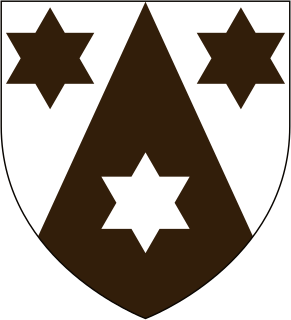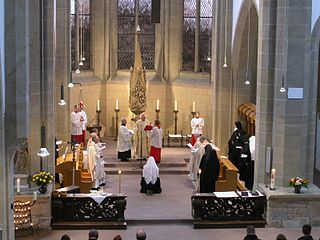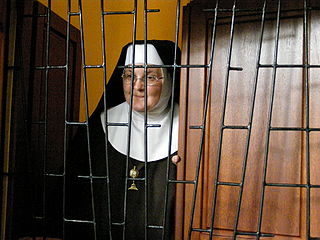 |
| Part of a series on the |
| Canon law of the Catholic Church |
|---|
Jus antiquum
Jus novum Jus novissiumum Jus codicis Other |
Trials and tribunals |
Canonical structures |
Philosophy, theology, and fundamental theory of canon law Contents |
Temporal goods (property) |
Procedural law Canonization Election of the Roman Pontiff |
Legal practice & scholarship Academic degrees Faculties & Professional Societies Canonists |
Institutes of Consecrated Life and Societies of Apostolic Life |

A Catholic religious order is a religious order of the Catholic Church. According to the 1983 Code of Canon Law, they form part of a category of Catholic religious institutes.
A religious order is a lineage of communities and organizations of people who live in some way set apart from society in accordance with their specific religious devotion, usually characterized by the principles of its founder's religious practice. The order is composed of laypeople and, in some orders, clergy. Religious orders exist in many of the world's religions.

The Catholic Church, also known as the Roman Catholic Church, is the largest Christian church, with approximately 1.3 billion baptised Catholics worldwide as of 2017. As the world's "oldest continuously functioning international institution", it has played a prominent role in the history and development of Western civilisation. The church is headed by the Bishop of Rome, known as the pope. Its central administration, the Holy See, is in the Vatican City, an enclave within the city of Rome in Italy.
The 1983 Code of Canon Law, also called the Johanno-Pauline Code, is the "fundamental body of ecclesiastical laws for the Latin Church". It is the second and current comprehensive codification of canonical legislation for the Latin Church sui iuris of the Catholic Church. It was promulgated on 25 January 1983 by John Paul II and took legal effect on the First Sunday of Advent 1983. It replaced the 1917 Code of Canon Law, promulgated by Benedict XV on 27 May 1917.
Subcategories are canons regular (canons and canonesses regular who recite the Divine Office and serve a church and perhaps a parish); monastics (monks or nuns living and working in a monastery and reciting the Divine Office); mendicants (friars or religious sisters who live from alms, recite the Divine Office, and, in the case of the men, participate in apostolic activities); and clerks regular (priests who take religious vows and have a very active apostolic life).

Canons regular are priests in the Latin Church living in community under a rule, and sharing their property in common.

The Liturgy of the Hours or Divine Office or Work of God or canonical hours, often referred to as the Breviary, is the official set of prayers "marking the hours of each day and sanctifying the day with prayer". It consists primarily of psalms supplemented by hymns, readings and other prayers and antiphons. Together with the Mass, it constitutes the official public prayer life of the Church. The Liturgy of the Hours also forms the basis of prayer within Christian monasticism.

A monk is a person who practices religious asceticism by monastic living, either alone or with any number of other monks. A monk may be a person who decides to dedicate his life to serving all other living beings, or to be an ascetic who voluntarily chooses to leave mainstream society and live his or her life in prayer and contemplation. The concept is ancient and can be seen in many religions and in philosophy.
Original Catholic religious orders of the Middle Ages include the Order of Saint Benedict, the Carmelites, the Order of Friars Minor, the Dominican Order, and the Order of Saint Augustine. As such, also the Teutonic Order may qualify, as today it is mainly monastic.

In the history of Europe, the Middle Ages lasted from the 5th to the 15th century. It began with the fall of the Western Roman Empire and merged into the Renaissance and the Age of Discovery. The Middle Ages is the middle period of the three traditional divisions of Western history: classical antiquity, the medieval period, and the modern period. The medieval period is itself subdivided into the Early, High, and Late Middle Ages.

The Order of the Brothers of the Blessed Virgin Mary of Mount Carmel or Carmelites is a Roman Catholic mendicant religious order founded, probably in the 12th century, on Mount Carmel in the Crusader States, hence the name Carmelites. However, historical records about its origin remain very uncertain. Berthold of Calabria has traditionally been associated with the founding of the order, but few clear records of early Carmelite history have survived.

The Order of Friars Minor is a mendicant Catholic religious order, founded in 1209 by Francis of Assisi. The order adheres to the teachings and spiritual disciplines of the founder and of his main associates and followers, such as Clare of Assisi, Anthony of Padua, and Elizabeth of Hungary, among many others. The Order of Friars Minor is considered to be the successor to the original Franciscan Order within the Catholic Church, and is the largest of the contemporary First Orders within the Franciscan movement.
In the past, what distinguished religious orders from other institutes was the classification of the vows that the members took in religious profession as solemn vows. According to this criterion, the last religious order founded was that of the Bethlehem Brothers in 1673. [1] Nevertheless, in the course of the 20th century, some religious institutes outside the category of orders obtained permission to make solemn vows, at least of poverty, thus blurring the distinction.
A vow is a promise or oath.
In Catholic canon law, a solemn vow is a vow that the Church has recognized as such.










